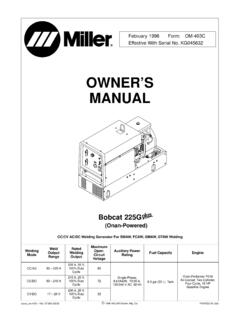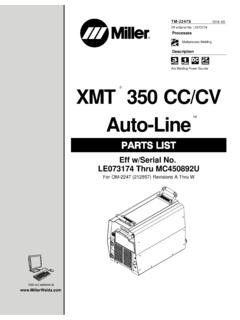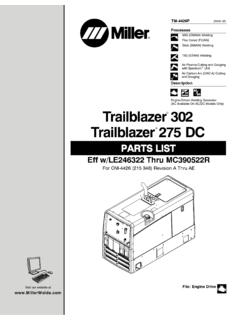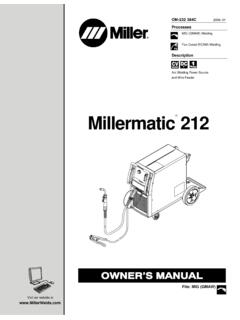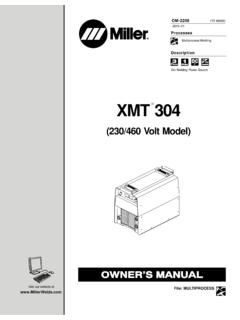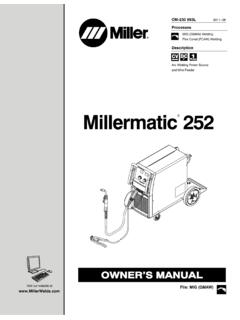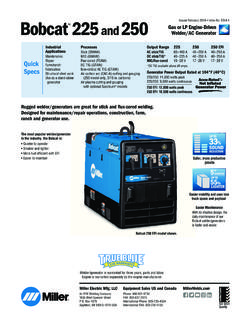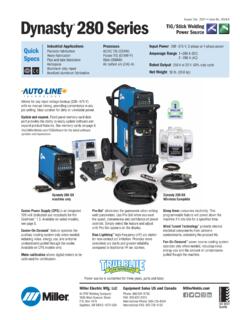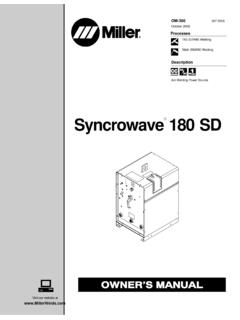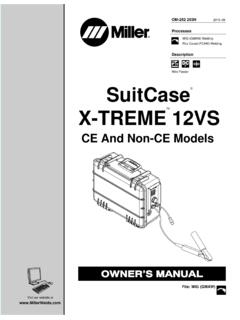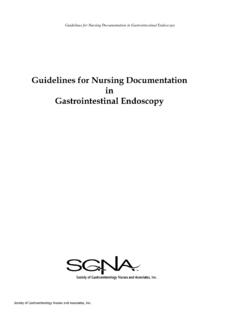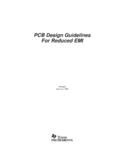Transcription of Guidelines For Shielded Metal Arc Welding (SMAW)
1 ProcessesStick (SMAW) Welding155095F2018 04 Guidelines ForShielded Metal ArcWelding (SMAW)For product information,Owner s Manual translations,and more, OF CONTENTSSECTION 1 SAFETY PRECAUTIONS - READ BEFORE Symbol Arc Welding Additional Symbols For Installation, Operation, And California Proposition 65 Principal Safety EMF 2 PRINCIPLES OF Shielded Metal ARC Welding (SMAW) 3 Shielded Metal ARC Welding (SMAW) Typical Stick Welding Electrode And Amperage Selection Striking An Arc Scratch Start Striking An Arc Tapping Positioning Electrode Electrode Movement During Conditions That Affect Weld Bead Poor Weld Bead Good Weld Bead Typical Weld Welding Groove (Butt) Welding Tee Welding Lap Welding Horizontal Beads And Groove (Butt) Welding Vertical Beads And Groove (Butt) Welding Vertical Tee Joints And Lap Welding Overhead Groove (Butt)
2 Joints And Tee Weld 4 Welding Excessive Incomplete Lack Of Excessive Waviness Of Page 1 SECTION 1 SAFETY PRECAUTIONS - READ BEFORE USINGsom 2018 017 Protect yourself and others from injury read, follow, and save these important safety precautions and operating Symbol UsageDANGER! Indicates a hazardous situation which, ifnot avoided, will result in death or serious injury. Thepossible hazards are shown in the adjoining symbolsor explained in the a hazardous situation which, if not avoided,could result in death or serious injury. The possiblehazards are shown in the adjoining symbols or ex-plained in the Indicates statements not related to personal special group of symbols means Warning!
3 Watch Out! ELECTRICSHOCK, MOVING PARTS, and HOT PARTS hazards. Consult sym-bols and related instructions below for necessary actions to avoid Arc Welding HazardsThe symbols shown below are used throughout this manualto call attention to and identify possible hazards. When yousee the symbol, watch out, and follow the related instructionsto avoid the hazard. The safety information given below isonly a summary of the more complete safety informationfound in the Safety Standards listed in Section 1-5. Read andfollow all Safety qualified persons should install, operate, maintain, andrepair this equipment. A qualified person is defined as onewho, by possession of a recognized degree, certificate, orprofessional standing, or who by extensive knowledge, train-ing and experience, has successfully demonstrated ability tosolve or resolve problems relating to the subject matter, thework, or the project and has received safety training to recog-nize and avoid the hazards operation, keep everybody, especially children, live electrical parts can cause fatal shocksor severe burns.
4 The electrode and work circuit iselectrically live whenever the output is on. The inputpower circuit and machine internal circuits are alsolive when power is on. In semiautomatic or automaticwire Welding , the wire, wire reel, drive roll housing,and all Metal parts touching the Welding wire areelectrically live. Incorrectly installed or improperlygrounded equipment is a not touch live electrical SHOCK can dry, hole-free insulating gloves and body yourself from work and ground using dry insulating matsor covers big enough to prevent any physical contact with the workor not use AC weld output in damp, wet, or confined spaces, or ifthere is a danger of AC output ONLY if required for the Welding AC output is required, use remote output control if present safety precautions are required when any of the follow-ing electrically hazardous conditions are present: in damplocations or while wearing wet clothing; on Metal structures suchas floors, gratings, or scaffolds.
5 When in cramped positions suchas sitting, kneeling, or lying; or when there is a high risk of unavoid-able or accidental contact with the workpiece or ground. For theseconditions, use the following equipment in order presented: 1) asemiautomatic DC constant voltage (wire) welder, 2) a DC manual(stick) welder, or 3) an AC welder with reduced open-circuit volt-age. In most situations, use of a DC, constant voltage wire welderis recommended. And, do not work alone!DDisconnect input power or stop engine before installing orservicing this equipment. Lockout/tagout input power according toOSHA 29 CFR (see Safety Standards).DProperly install, ground, and operate this equipment according toits Owner s Manual and national, state, and local verify the supply ground check and be sure that inputpower cord ground wire is properly connected to ground terminal indisconnect box or that cord plug is connected to a properlygrounded receptacle making input connections, attach proper grounding conduc-tor first double-check cords dry, free of oil and grease, and protected from hot metaland inspect input power cord and ground conductor fordamage or bare wiring replace immediately if damaged barewiring can off all equipment when not in not use worn, damaged, undersized.
6 Or repaired not drape cables over your earth grounding of the workpiece is required, ground it directlywith a separate not touch electrode if you are in contact with the work, ground,or another electrode from a different not touch electrode holders connected to two Welding ma-chines at the same time since double open-circuit voltage will only well-maintained equipment. Repair or replace damagedparts at once. Maintain unit according to a safety harness if working above floor all panels and covers securely in work cable with good Metal -to- Metal contact to workpieceor worktable as near the weld as work clamp when not connected to workpiece to preventcontact with any Metal not connect more than one electrode or work cable to anysingle weld output terminal.
7 Disconnect cable for process not GFCI protection when operating auxiliary equipment in dampor wet DC VOLTAGE exists in inverter weld-ing power sources AFTER removal of input off unit, disconnect input power, and discharge input capaci-tors according to instructions in Manual before touching any PARTS can not touch hot parts bare cooling period before working handle hot parts, use proper tools and/or wear heavy, insu-lated Welding gloves and clothing to prevent Page 2 Welding produces fumes and gases. Breathingthese fumes and gases can be hazardous to AND GASES can be your head out of the fumes. Do not breathe the the work area and/or use local forced ventilation at the arcto remove Welding fumes and gases.
8 The recommended way todetermine adequate ventilation is to sample for the compositionand quantity of fumes and gases to which personnel are ventilation is poor, wear an approved air-supplied and understand the Safety Data Sheets (SDSs) and themanufacturer s instructions for adhesives, coatings, cleaners,consumables, coolants, degreasers, fluxes, and in a confined space only if it is well ventilated, or whilewearing an air-supplied respirator. Always have a trained watch-person nearby. Welding fumes and gases can displace air andlower the oxygen level causing injury or death. Be sure the breath-ing air is not weld in locations near degreasing, cleaning, or spraying op-erations. The heat and rays of the arc can react with vapors to formhighly toxic and irritating not weld on coated metals, such as galvanized, lead, orcadmium plated steel, unless the coating is removed from the weldarea, the area is well ventilated, and while wearing an air-suppliedrespirator.
9 The coatings and any metals containing these elementscan give off toxic fumes if rays from the Welding process produce intensevisible and invisible (ultraviolet and infrared) raysthat can burn eyes and skin. Sparks fly off from an approved Welding helmet fitted with a proper shade offilter lenses to protect your face and eyes from arc rays andsparks when Welding or watching (see ANSI and in Safety Standards).DWear approved safety glasses with side shields under protective screens or barriers to protect others from flash,glare and sparks; warn others not to watch the body protection made from durable, flame resistant mate-rial (leather, heavy cotton, wool). Body protection includesoil-free clothing such as leather gloves, heavy shirt, cufflesstrousers, high shoes, and a RAYS can burn eyes and on closed containers, such as tanks,drums, or pipes, can cause them to blow up.
10 Sparkscan fly off from the Welding arc. The flying sparks, hotworkpiece, and hot equipment can cause fires andburns. Accidental contact of electrode to Metal objects can causesparks, explosion, overheating, or fire. Check and be sure the area issafe before doing any can cause fire or all flammables within 35 ft ( m) of the Welding arc. Ifthis is not possible, tightly cover them with approved not weld where flying sparks can strike flammable yourself and others from flying sparks and hot alert that Welding sparks and hot materials from Welding caneasily go through small cracks and openings to adjacent for fire, and keep a fire extinguisher aware that Welding on a ceiling, floor, bulkhead, or partition cancause fire on the hidden not cut or weld on tire rims or wheels.
